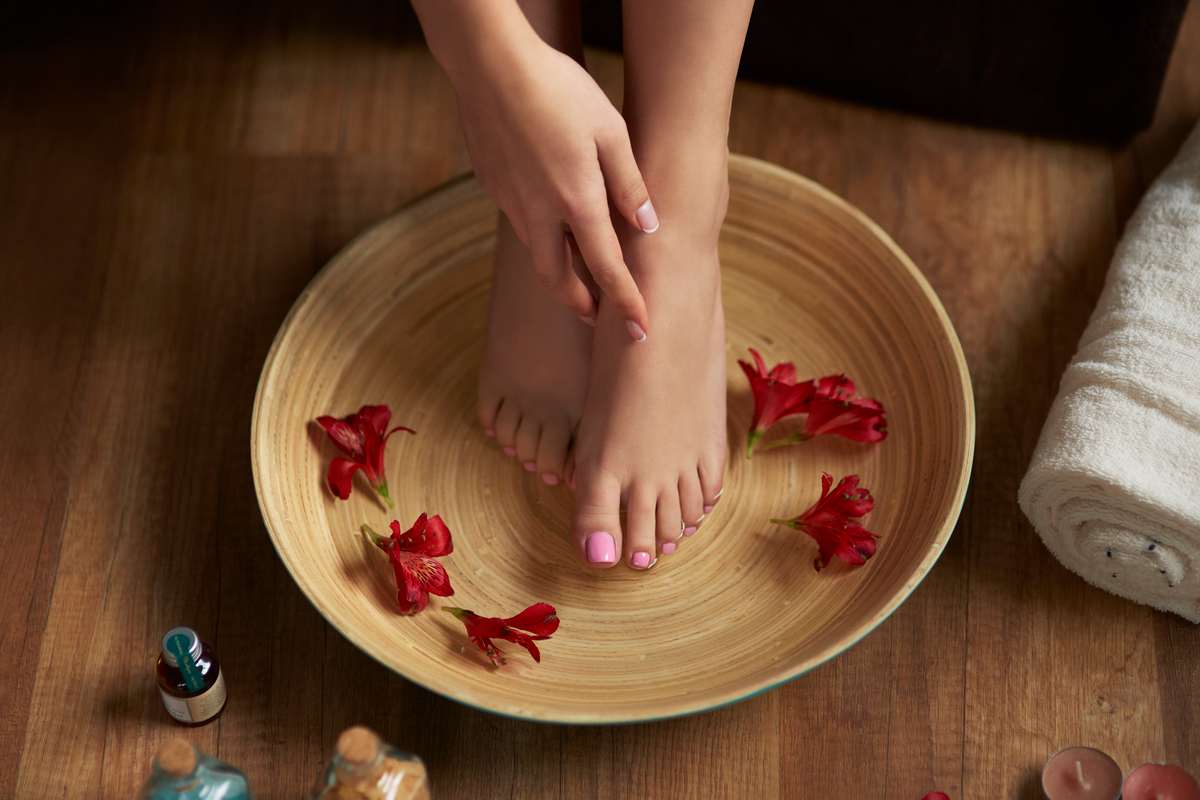Do you have thick patches of lifeless skin on your feet? If so, you’re not alone. Numerous people develop dead skin on feet over time because they are frequently neglected or ignored completely. Dead skin cells grow gradually on the feet and can get thick, dull, and dead. Not only are they hard to wipe out but can obstruct pores, which could lead to a rash. The membrane of dead skin on feet can also cause uneasy itching and surely that isn’t very comfortable.
Thick dead skin on feet is a part of the normal human decomposition cycle and is often peeling and shaping membranes on top of one another. There is no particular reminder that indicates when the time for peeling has come, but it could occur at any time and for different reasons.
Lifeless or loose membrane cropping up on the feet is your foot’s way of commonly exfoliating and removing dead skin cells.
Deceased skin can grow because of an absence of moisture if your feet are often in closed shoes or socks or from the friction of walking or running. It can also crop up if you don’t regularly look after, exfoliate, or clean your feet. The dead skin on feet may seem dry, broken, loose, or hanging. It’s usually not uncomfortable unless it’s an outcome of an athlete’s foot, eczema, or another kind of infection.
This article will sum up what results in dead skin, the applicable procedures to eliminate dead skin from feet at home, and how to remove thick dead skin from feet. So, worry not, you can now feel more pleasant stepping around and confidently show your soft heels while wearing sandals or open shoes this summer!
Quick Access
Why do I have the thick dead skin on my Feet?
There are several causes of peeling feet, including:
Corns and calluses

Corns and calluses both spur dead skin to grow. This can lead to thick, prickling growths on the feet that occasionally crack open or peel. Removing them down to the surface of the membrane may cause bleeding or injury.
Calluses manage to occur underneath the feet and feel harsh. They are usually not unbearable but can be tender to the senses. Corns cause dead skin to accumulate around infuriated skin, which may hurt. They look waxy and often develop on the toes.
Corns and calluses are not hazardous, but they can be uneasy. Folk should not try to cut them off or peel them off, as this may result in painful wounds and infections.
Dry skin
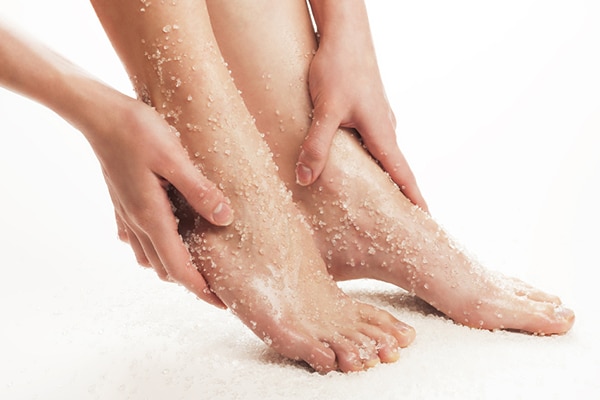
Dry skin, particularly in the winter months and in dusty climates, may induce the feet to become so dry that they peel or crack open and bleed.
An individual may also have other indications on their feet, such as:
- flushing
- white or dry patches
- itching
- pain
Dry skin feet are not hazardous. Yet, if it is serious enough to provoke the skin of the feet to crack open, there may be a greater risk of infection.
Eczema
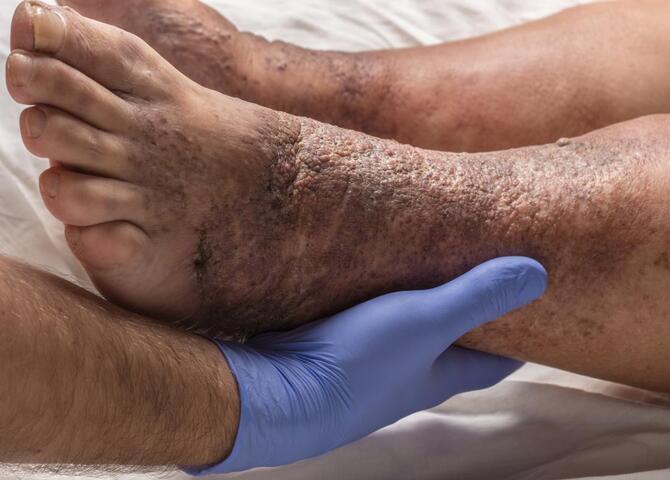
Eczema is a kind of inflammatory skin disease that results in the body overreacting to harmless materials. This can lead to rashes in healthy skin.
The surface may look or feel barren, but eczema is not only dry skin. It can also result in bitterly flushed or white patches and even blisters.
Atopic dermatitis, which is an extensively popular form of eczema, arises when the immune system harms the skin’s moisture boundary, causing it to become barren. This may result in peeling feet. A person may also have eczema patches on other portions of the body.
Dyshidrotic eczema especially impacts the hands and feet, and it can result in tiny flushed blisters on the toes. These blisters may be scratchy and peel or break open. Some people misunderstand this type of eczema for different kinds of blisters, as they appear identical.
Psoriasis
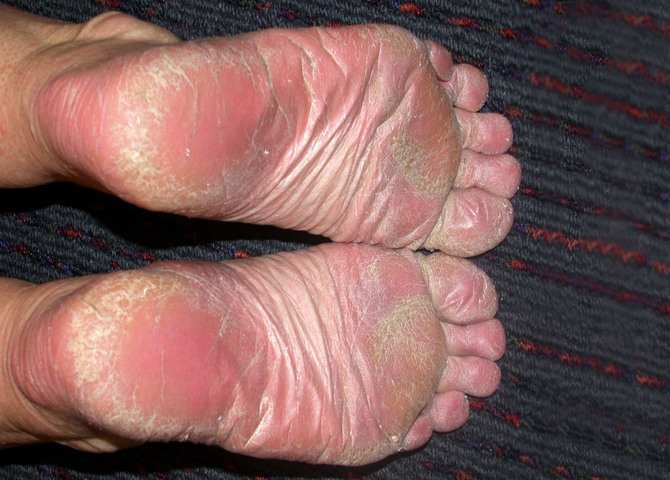
Psoriasis is a chronic autoimmune situation that results in the body attacking healthy tissue. This affects skin cells to turn over much earlier than usual. It can arise anywhere on the body but generally includes the elbows, knees, and bottoms of the feet.
People with psoriasis may recognize flushed, thickened patches that look grey or silvery on their feet. The skin may scrape, itch, or roll yellow over time. Although dry skin does not inflict psoriasis, moistening the skin may help psoriasis recover more instantly.
Athlete’s foot
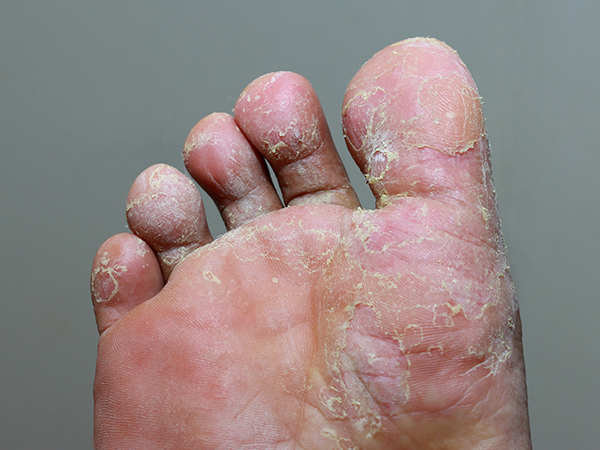
Athletes’ feet are a highly contagious fungal affliction that may result in yellow or white patches on the feet, toes, or regions under the nails.
The feet may sting or look barren, and the surface may occasionally peel. An individual is more likely to suffer from an athlete’s foot when their feet come in touch with contaminated surfaces, such as gym bases or showers.
Blisters
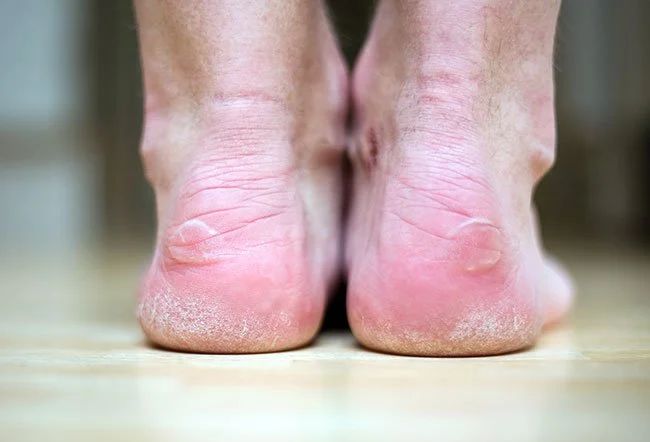
Blisters usually occur when something rubs against the paw, affecting small, fluid-filled lumps to develop.
Blisters are generally harmless, but they can be unbearable. Wearing shoes that rub on similar regions of the feet may result in blisters cracking open and bleeding. People should not burst a blister, as it may become unbearable and bleed. Bursting a blister may also intensify the danger of infection.
Diabetes-related foot health issues
Diabetes can damage blood vessels, which may impact blood flow to the feet. The deduction in blood flow intensifies the risk of several foot problems, including dry skin that cracks open and bleeds.
An individual with diabetes and foot injury or dry membrane that does not go away should get to a doctor.
An individual with peeling skin on their feet should contact a doctor if they:
- have diabetes and acquire foot injury or numbness
- experience indications that do not get better with home medication
- have serious foot pain that interferes with walking
- develop any indications or signs of an infection, such as a fever
- get an item, such as glass or wood, stuck in their foot
- injure their foot by walking on an object and have not lately had a tetanus shot
How to remove thick dead skin from feet?
1. Pumice stone
A pumice stone is a biological lava stone that can
remove dead skin from your feet as well as calluses from your feet.
How to use:
First of all, dip the pumice stone in mild water. You can also moisten your feet in warm water for 10 minutes to alleviate them. Now gently move the stone in a circular or diagonal motion around your foot to wipe out dead skin. Emphasis on eliminating the prime layer of the skin and not the whole region of dead skin will enable the promotion of healthy cell turnover. Apply lotion or oil thereafter to enable you to soften your feet. Remember, never apply a pumice stone on injured or sore areas.
2. Paraffin wax
Many nail salons use paraffin wax as an add-on for pedicure therapy. Paraffin wax is a soft wax that’s softened at a normal temperature of over 125°F (51°C). The wax shouldn’t be heated enough to simmer or disturb your skin.
You can similarly do a paraffin wax treatment at home by taking up an at-home paraffin wax bath, or you can soften the wax in a saucepan and then transfer it to a container for dipping your feet. During paraffin wax therapy, you’ll dip your feet in the wax numerous times. After several coverings of wax are applied, cover your feet in plastic.
Later when the wax hardens, you can peel off the wax. Any thick dead skin on feet will be eliminated along with the wax. Your feet should feel soft thereafter.
Do not use paraffin wax if:
- you have low blood circulation
- you have an epidemic or open sore on your feet
- you’ve lost sensation in your feet, such as from diabetic neuropathy
- If you try paraffin wax at home, be very careful and control the temperature of the wax with a candy thermometer.
3. Foot scrub
Most apothecaries and drug stores sell several foot scrubs over the counter. Go for one with granules that will enable you to scrub away the dead skin feet.
Or, you can also make your own by saturating two tablespoons of sea salt into identical quantities of baby oil and lemon juice.
To use a foot scrub, apply the scrub directly to your foot and wipe gently with your palm. Or use a foot scrub brush or sponge to wipe out the dead skin. Wash out the scrub entirely with warm water after usage.
4. Oatmeal scrub
You can utilize oatmeal to prepare an at-home exfoliator to remove dead skin from your feet.
To make the scrub, mix identical parts of oatmeal with rose water or milk to prepare a paste.
- Apply the scrub to your feet and let it sit for up to 20 to 30 minutes.
- Use a foot scuffle to exfoliate your feet.
- Soak with cold water and let your feet dry.
- Apply a foot ointment.
- Do this procedure every other day for favorable results.
5. Epsom salt soak or scrub
Epsom salt is a crystal form of magnesium sulfate. You can rinse your feet in Epsom salt that’s decomposed in water. It can enable exfoliation and smooth dry, broken-down feet. This, in turn, may enable the removal of dead skin.
To use:
- Formulate an Epsom salt soak by sprinkling 1/2 cup of salt into a footbath or a wide cup into a bathtub with ample warm water.
- Loosen up and rinse for up to 20 minutes.
- You may utilize a pumice stone or foot brush after to support removing dehydrated skin.
- To create an Epsom salt scrub for your feet, in the shower or bath, mix a bit of Epsom salt with a tablespoon of bath or olive oil in your hand or on a bath sponge.
- Wipe gently over moist skin to exfoliate, soften, and eliminate dead skin before rinsing off with water.
6. Vinegar soak
Vinegar soaks may enable softening feet and enable you to wipe out dead, dry, or cracked skin. You can utilize nearly any type of vinegar. Apple cider vinegar or white vinegar are prominent options, and you may already have them in your kitchen.
Use cold water to create the soak, as hot water may dry out the skin further. Use 1 part vinegar to 2 parts water as a common approach. Soak your feet for 5 to 10 minutes to begin.
If desired, proceed with the soak by using a pumice stone to eliminate dry or loose skin utilizing the procedures above. Apply moisturizer, petroleum jelly, or coconut oil before slipping on socks to plug in moisture after doing a vinegar soak.
Follow this procedure a few times a week as it can further dry the skin.
7. Baby foot peel
Baby Foot Peel is a traditional, 1-hour, at-home treatment to remove dead skin from feet and soften them.
To use it, you’ll have to apply the given plastic “booties” to your feet for up to one hour. They include a gel mixture of fruit acid and additional moisturizers that may work for dead skin “shed” from your feet.
Discern all instructions for use on the package:
- After cleaning your feet, you’ll secure the plastic “booties” to your feet with sticky tape.
- Leave the booties for up to one hour.
- Peel off booties and rinse your feet gently with foam and water.
- You’ll need to wet your feet daily for peeling to occur over the next three to seven days.
While there haven’t been any scientific studies supporting the advantages or usefulness of this medication, it has a very prominent following online of loyal users. Use it cautiously
8. Baking soda soak
Baking soda is a traditional at-home treatment for the eviction of deceased skin from the feet. But some dermatologists instruct that baking soda can be disturbing, cause redness, and dry out the membrane further. That’s because it may disrupt the skin’s normal pH balance.
If you suffer from any skin sensitivities or allergies then don’t use baking soda on your feet. Always examine with your specialist or podiatrist before experimenting with a new medication. If you choose to use baking soda, only use a minor amount (2-3 tablespoons) in an entire foot bath of warm water for 10-20 minutes.
After your soak, gently use a foot brush to follow the procedure mentioned above to wipe out the dead skin. Apply an abundance of moisturizers after. If you undergo any redness or discomfort while soaking your feet, instantly remove them from the solution.
9. Lemon water soak
The sharpness in lemon may enable the removal of dead skin cells from your feet. Yet, besides baking soda, using lemon on your feet may infringe on the skin’s normal pH balance and lead to more dryness and deceased skin.
Avoid lemon if you:
- have any damages or open sores on your foot
- have delicate skin
- experience any redness and pain
Survey with a podiatrist or dermatologist before using lemon, or if you have any doubts or troubles.
If you decide to use this method:
- Assemble a footbath with warm water.
- Pinch in lemon juice from one lemon. You can also put pieces of lemon peel in the liquid.
- Moisten your feet for up to 15 minutes.
- Use a foot brush to scrub lifeless skin off your feet. Rinse and dry your feet entirely.
- Apply a moisturizer or coconut oil, if needed.
- Use a Razor or scraper
- Only allow a podiatrist or other skilled medical professional to peel off the callus from your foot with a razor or scraper.
Do not try razors or scrapers on your feet yourself. Doing so could result in injury to your foot or initiate another medical issue.
If you’re concerned about eliminating dry or dead skin, see your doctor for alternative treatment or at-home medications.
Prevention
As the saying goes, ‘prevention is always
better than cure;’ you must accept the essential norms to prohibit dead skin there are a few kinds of stuff you can do –
- Sustain foot hygiene. Soak your feet regularly with soap and water.
- The layer near your feet tends to get limited moisture. Thus, you are required to deliver your hydrating moisturizer and apply it before you go to sleep.
- Wear shoes that accommodate you perfectly. Wash your socks every day and wear a neat dry pair of socks.
- Ignore using soaps, lotions, etc that have alcohol content, or added odors.
- Have footbaths at least once a week, using warm water.
Peeling feet may be painful. There are various probable reasons, and the best medication or home care option will depend on the cause. Usually, an individual can deal with dry skin at home with moisturizers. If it comes to be severe, however, they should consider seeking guidance from a specialist.
A specialist may specify prescriptions to manage persistent conditions, such as psoriasis, which may increase peeling feet.

